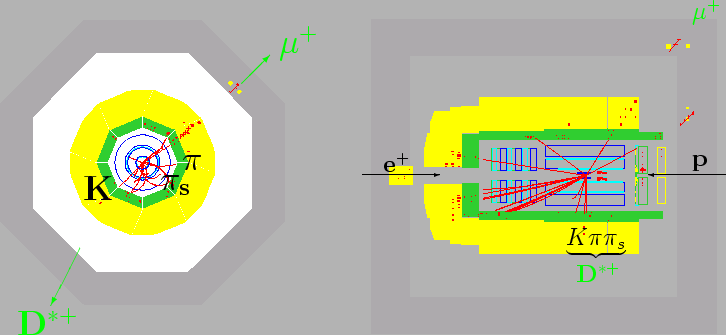The electron proton storage ring HERA (fig.8)
at the DESY laboratory in Hamburg collides 27.5 GeV electrons or positrons
with 920 GeV protons2.
The storage ring has a circumference of
![]() and
consists of two separate accelerators. The beams are segmented
into 180 colliding bunches each, providing a bunch crossing rate of 10 MHz.
Four experiments are situated at HERA. The two collider experiments
H1 and ZEUS have been in operation since 1992. In 1995 the HERMES
experiment started data taking using the polarized electron beam
on a fixed polarized gas target [134].
The HERA-B proton-proton fixed target experiment was
operated between 1998 and 2003.
HERA-B makes use of the proton beam halo using
a wire target [135].
and
consists of two separate accelerators. The beams are segmented
into 180 colliding bunches each, providing a bunch crossing rate of 10 MHz.
Four experiments are situated at HERA. The two collider experiments
H1 and ZEUS have been in operation since 1992. In 1995 the HERMES
experiment started data taking using the polarized electron beam
on a fixed polarized gas target [134].
The HERA-B proton-proton fixed target experiment was
operated between 1998 and 2003.
HERA-B makes use of the proton beam halo using
a wire target [135].
 |
The H1 and ZEUS detectors are typical multi-purpose collider
experiments. A schematic view of the ZEUS detector is shown
in fig.9.
The physics programs comprise
the full spectrum of QCD studies, measurements of the proton
structure functions and exclusive hadronic final states,
as well as electroweak physics and searches for new physics
phenomena [136].
With an ![]() center-of-mass energy of 320 GeV
the HERA collider experiments H1 and ZEUS are close to
the present energy frontier for accelerator based experiments.
Only the Tevatron experiments CDF and D0 [137,138] have access
to higher center-of-mass energies.
Events in deep inelastic
center-of-mass energy of 320 GeV
the HERA collider experiments H1 and ZEUS are close to
the present energy frontier for accelerator based experiments.
Only the Tevatron experiments CDF and D0 [137,138] have access
to higher center-of-mass energies.
Events in deep inelastic ![]() scattering
have been measured down to values of
scattering
have been measured down to values of ![]() as low
as
as low
as
![]() and up to values of
and up to values of ![]() of
of
![]() GeV
GeV![]() .
In QCD, measurements of exclusive final states comprise
jet physics, heavy flavour production, processes in hard and soft
diffraction and hadron spectroscopy.
.
In QCD, measurements of exclusive final states comprise
jet physics, heavy flavour production, processes in hard and soft
diffraction and hadron spectroscopy.
In the years between 1992 and 2000 the collider experiments H1 and ZEUS collected an integrated luminosity of 100 pb
The designs of the H1 and ZEUS detectors were chosen to be somewhat
complementary, with emphasis on the reconstruction
of the scattered electron in the case of H1 and on the
precise calorimetric measurement
of the hadronic final states in the case of ZEUS.
Both experiments are capable of the triggering and
reconstruction of events with heavy quark contents down to very low
transverse momenta
![]() GeV.
Charmonium is measured using the decays into leptons down
to
GeV.
Charmonium is measured using the decays into leptons down
to
![]() .
A heavy quark candidate event in the H1 experiment
is displayed in fig.10.
.
A heavy quark candidate event in the H1 experiment
is displayed in fig.10.
In the following the experiments H1 and ZEUS are described3, emphasizing those components that are most relevant for the triggering and reconstruction of heavy quark events, i.e.the tracking and vertexing detectors and the detectors used for lepton identification.
 |